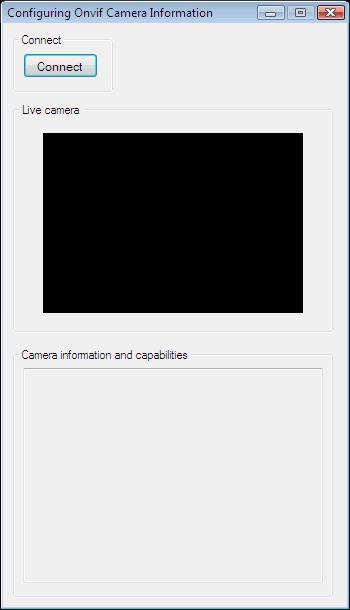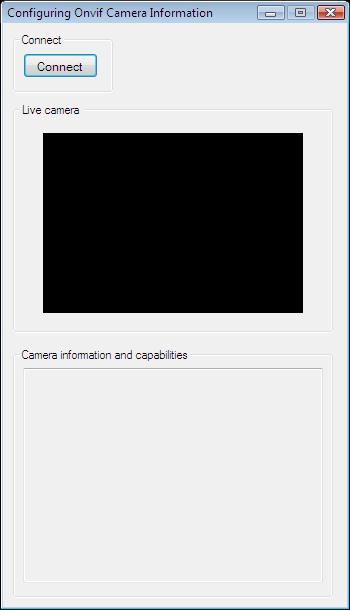How to get detailed camera information and capabilities in C#
This example demonstrates a simple method for how you can get detailed camera information and capabilities of your camera in C#. To implement this example, you need to have Ozeki Camera SDK installed, and a reference to OzekiSDK.dll should be added to your Visual Studio project.
How to get detailed camera information and capabilities using C#?
To establish the connection properly between your application and an IP camera you should apply the same code snippet you have used in the example (How to connect to an IP camera device using C#?). Important: you should study this article in order to find out how to setup your Windows Forms/WPF Application correctly.
Getting started
To get started it is recomended to Download and Install the latest version of Ozeki Camera SDK. After installation you can find the example code discussed in this page with full source code in the following location on your harddisk:
| Download Ozeki Camera SDK: | https://camera-sdk.com/p_6513-download-onvif-ozeki-camera-sdk-for-c-sharp.html |
| Windows forms version: | C:\Program Files\Ozeki\Ozeki SDK\examples.zip\Examples\Other\Configure_Camera_Information_WF\Configure_Camera_Information_WF.sln |
| WPF version: | C:\Program Files\Ozeki\Ozeki SDK\examples.zip\Examples\Other\Configure_Camera_Information_WPF\Configure_Camera_Information_WPF.sln |
To compile this example you will need Microsoft Visual Studio installed on your computer.
The additional methods of this example are the following:
Subscribing to the CameraStateChanged event of the camera object:
_camera.CameraStateChanged += _camera_CameraStateChanged;
When the ''Streaming'' event occurs, you can inform the user by writing the information and the capabilities of the camera to the label:
textBox_Info.Text = GetDeviceInfo();
In the GetDeviceInfo() method you can get information and capabilities of your camera by getting the _camera object's properties.
Getting detailed camera information and capabilities example in C#
| Windows Form | WPF |
Windows forms version
Form1.cs
using System;
using System.Drawing;
using System.Text;
using System.Windows.Forms;
using Ozeki.Media;
using Ozeki.Camera;
namespace ConfigureOnvifCameraRemotely01
{
public partial class Form1 : Form
{
private IIPCamera _camera;
private DrawingImageProvider _imageProvider;
private MediaConnector _connector;
private VideoViewerWF _videoViewerWf;
public Form1()
{
InitializeComponent();
_connector = new MediaConnector();
_imageProvider = new DrawingImageProvider();
_videoViewerWf = new VideoViewerWF();
SetVideoViewer();
}
private void SetVideoViewer()
{
CameraBox.Controls.Add(_videoViewerWf);
_videoViewerWf.Size = new Size(260, 180);
_videoViewerWf.BackColor = Color.Black;
_videoViewerWf.TabStop = false;
_videoViewerWf.FlipMode = FlipMode.None;
_videoViewerWf.Location = new Point(30, 30);
_videoViewerWf.Name = "_videoViewerWf";
}
private void button_Connect_Click(object sender, EventArgs e)
{
_camera = new IPCamera("192.168.112.109:8080", "user", "qwe123");
_camera.CameraStateChanged += _camera_CameraStateChanged;
_connector.Connect(_camera.VideoChannel, _imageProvider);
_videoViewerWf.SetImageProvider(_imageProvider);
_videoViewerWf.Start();
_camera.Start();
}
private void _camera_CameraStateChanged(object sender, CameraStateEventArgs e)
{
if (e.State == CameraState.Streaming)
InvokeGuiThread(() => textBox_Info.Text = GetDeviceInfo());
}
private string GetDeviceInfo()
{
var sb = new StringBuilder();
sb.AppendLine("Firmware - " + _camera.CameraInfo.DeviceInfo.Firmware + "\n");
sb.AppendLine("Hardware ID - " + _camera.CameraInfo.DeviceInfo.HardwareId + "\n");
sb.AppendLine("Manufacture - " + _camera.CameraInfo.DeviceInfo.Manufacturer + "\n");
sb.AppendLine("Model - " + _camera.CameraInfo.DeviceInfo.Model + "\n");
sb.AppendLine("Serial number - " + _camera.CameraInfo.DeviceInfo.SerialNumber + "\n");
sb.AppendLine("Discoverable - " + _camera.CameraInfo.Discoverable + "\n");
sb.AppendLine("Date and time - " + _camera.DateAndTime + "\n");
sb.AppendLine("Domainhost - " + _camera.DomainHost + "\n");
sb.AppendLine("Username - " + _camera.UserName + "\n");
sb.AppendLine("PTZ supported - " + _camera.IsPTZSupported + "\n");
sb.AppendLine("Back Light Compensation supported - " + _camera.ImagingSettings.IsBackLightCompensationSupported + "\n");
sb.AppendLine("Brightness supported - " + _camera.ImagingSettings.IsBrightnessSupported + "\n");
sb.AppendLine("Color Saturation supported - " + _camera.ImagingSettings.IsColorSaturationSupported + "\n");
sb.AppendLine("Contrast supported - " + _camera.ImagingSettings.IsContrastSupported + "\n");
sb.AppendLine("Sharpness supported - " + _camera.ImagingSettings.IsSharpnessSupported + "\n");
sb.AppendLine("White Balance supported - " + _camera.ImagingSettings.IsWhiteBalanceSupported + "\n");
return sb.ToString();
}
private void InvokeGuiThread(Action action)
{
BeginInvoke(action);
}
}
}
Please note that none of the cancel and disconnect methods are included in the example because of the demonstrating intent and briefness of the article.
GUI

After the successful implementation of the functions and the GUI elements, the application will work properly. Pressing the connect button will load in the image of the IP camera device connected to your PC into the panel that you can see on the picture. After you have connected to an onvif camera successfully, you can see information and capabilities of your camera.
Below you can find the code that belongs to the interface of the previously presented application. With the help of this section your Windows Forms Application will be able to work properly.
Form1.Designer.cs
namespace ConfigureOnvifCameraRemotely01
{
partial class Form1
{
private System.ComponentModel.IContainer components = null;
protected override void Dispose(bool disposing)
{
if (disposing && (components != null))
{
components.Dispose();
}
base.Dispose(disposing);
}
private void InitializeComponent()
{
this.groupBox1 = new System.Windows.Forms.GroupBox();
this.button_Connect = new System.Windows.Forms.Button();
this.CameraBox = new System.Windows.Forms.GroupBox();
this.groupBox2 = new System.Windows.Forms.GroupBox();
this.textBox_Info = new System.Windows.Forms.TextBox();
this.groupBox1.SuspendLayout();
this.groupBox2.SuspendLayout();
this.SuspendLayout();
//
// groupBox1
//
this.groupBox1.Controls.Add(this.button_Connect);
this.groupBox1.Location = new System.Drawing.Point(10, 10);
this.groupBox1.Name = "groupBox1";
this.groupBox1.Size = new System.Drawing.Size(100, 60);
this.groupBox1.TabIndex = 0;
this.groupBox1.TabStop = false;
this.groupBox1.Text = "Connect";
//
// button_Connect
//
this.button_Connect.Font = new System.Drawing.Font("Microsoft Sans Serif", 8.5F, System.Drawing.FontStyle.Regular, System.Drawing.GraphicsUnit.Point, ((byte)(238)));
this.button_Connect.ForeColor = System.Drawing.Color.Black;
this.button_Connect.Location = new System.Drawing.Point(10, 20);
this.button_Connect.Name = "button_Connect";
this.button_Connect.Size = new System.Drawing.Size(75, 25);
this.button_Connect.TabIndex = 6;
this.button_Connect.Text = "Connect";
this.button_Connect.UseVisualStyleBackColor = true;
this.button_Connect.Click += new System.EventHandler(this.button_Connect_Click);
//
// CameraBox
//
this.CameraBox.Location = new System.Drawing.Point(10, 80);
this.CameraBox.Name = "CameraBox";
this.CameraBox.Size = new System.Drawing.Size(320, 230);
this.CameraBox.TabIndex = 3;
this.CameraBox.TabStop = false;
this.CameraBox.Text = "Live camera ";
//
// groupBox2
//
this.groupBox2.Controls.Add(this.textBox_Info);
this.groupBox2.Location = new System.Drawing.Point(10, 325);
this.groupBox2.Name = "groupBox2";
this.groupBox2.Size = new System.Drawing.Size(320, 250);
this.groupBox2.TabIndex = 4;
this.groupBox2.TabStop = false;
this.groupBox2.Text = "Camera information and capabilities";
//
// textBox_Info
//
this.textBox_Info.Location = new System.Drawing.Point(10, 20);
this.textBox_Info.Multiline = true;
this.textBox_Info.Name = "textBox_Info";
this.textBox_Info.ReadOnly = true;
this.textBox_Info.Size = new System.Drawing.Size(300, 215);
this.textBox_Info.TabIndex = 0;
//
// Form1
//
this.AutoScaleDimensions = new System.Drawing.SizeF(6F, 13F);
this.AutoScaleMode = System.Windows.Forms.AutoScaleMode.Font;
this.ClientSize = new System.Drawing.Size(344, 584);
this.Controls.Add(this.groupBox2);
this.Controls.Add(this.CameraBox);
this.Controls.Add(this.groupBox1);
this.FormBorderStyle = System.Windows.Forms.FormBorderStyle.FixedDialog;
this.MaximizeBox = false;
this.Name = "Form1";
this.StartPosition = System.Windows.Forms.FormStartPosition.CenterScreen;
this.Text = "Configuring Onvif Camera Information";
this.groupBox1.ResumeLayout(false);
this.groupBox2.ResumeLayout(false);
this.groupBox2.PerformLayout();
this.ResumeLayout(false);
}
private System.Windows.Forms.GroupBox groupBox1;
private System.Windows.Forms.Button button_Connect;
private System.Windows.Forms.GroupBox CameraBox;
private System.Windows.Forms.GroupBox groupBox2;
private System.Windows.Forms.TextBox textBox_Info;
}
}
WPF version
MainWindow.xaml.cs
using System;
using System.Text;
using System.Windows;
using Ozeki.Media;
using Ozeki.Camera;
namespace ConfigureOnvifCameraRemotely01Wpf
{
///
/// Interaction logic for MainWindow.xaml
///
public partial class MainWindow : Window
{
private IIPCamera _camera;
private DrawingImageProvider _drawingImageProvider;
private MediaConnector _connector;
public MainWindow()
{
InitializeComponent();
_drawingImageProvider = new DrawingImageProvider();
_connector = new MediaConnector();
videoViewer.SetImageProvider(_drawingImageProvider);
}
private void Connect_Click(object sender, RoutedEventArgs e)
{
_camera = new IPCamera("192.168.112.109:8080", "user", "qwe123");
_camera.CameraStateChanged += _camera_CameraStateChanged;
_connector.Connect(_camera.VideoChannel, _drawingImageProvider);
_camera.Start();
videoViewer.Start();
}
private void _camera_CameraStateChanged(object sender, CameraStateEventArgs e)
{
if (e.State == CameraState.Streaming)
InvokeGuiThread(() => textBox_Info.Text = GetDeviceInfo());
}
private string GetDeviceInfo()
{
var sb = new StringBuilder();
sb.AppendLine("Firmware - " + _camera.CameraInfo.DeviceInfo.Firmware + "\n");
sb.AppendLine("Hardware ID - " + _camera.CameraInfo.DeviceInfo.HardwareId + "\n");
sb.AppendLine("Manufacture - " + _camera.CameraInfo.DeviceInfo.Manufacturer + "\n");
sb.AppendLine("Model - " + _camera.CameraInfo.DeviceInfo.Model + "\n");
sb.AppendLine("Serial number - " + _camera.CameraInfo.DeviceInfo.SerialNumber + "\n");
sb.AppendLine("Discoverable - " + _camera.CameraInfo.Discoverable + "\n");
sb.AppendLine("Date and time - " + _camera.DateAndTime + "\n");
sb.AppendLine("Domainhost - " + _camera.DomainHost + "\n");
sb.AppendLine("Username - " + _camera.UserName + "\n");
sb.AppendLine("PTZ supported - " + _camera.IsPTZSupported + "\n");
sb.AppendLine("Back Light Compensation supported - " + _camera.ImagingSettings.IsBackLightCompensationSupported + "\n");
sb.AppendLine("Brightness supported - " + _camera.ImagingSettings.IsBrightnessSupported + "\n");
sb.AppendLine("Color Saturation supported - " + _camera.ImagingSettings.IsColorSaturationSupported + "\n");
sb.AppendLine("Contrast supported - " + _camera.ImagingSettings.IsContrastSupported + "\n");
sb.AppendLine("Sharpness supported - " + _camera.ImagingSettings.IsSharpnessSupported + "\n");
sb.AppendLine("White Balance supported - " + _camera.ImagingSettings.IsWhiteBalanceSupported + "\n");
return sb.ToString();
}
private void InvokeGuiThread(Action action)
{
Dispatcher.BeginInvoke(action);
}
}
}
Please note that none of the cancel and disconnect methods are included in the example because of the demonstrating intent and briefness of the article.
GUI

After the successful implementation of the functions and the GUI elements, the application will work properly. Pressing the connect button will load in the image of the IP camera device connected to your PC into the panel that you can see on the picture. After you have connected to an onvif camera successfully, you can see information and capabilities of your camera.
Below you can find the code that belongs to the interface of the previously presented application. With the help of this section your WPF Application will be able to work properly.
MainWindow.xaml
<Window x:Class="ConfigureOnvifCameraRemotely01Wpf.MainWindow"
xmlns="http://schemas.microsoft.com/winfx/2006/xaml/presentation"
xmlns:x="http://schemas.microsoft.com/winfx/2006/xaml"
xmlns:controls="clr-namespace:Ozeki.Media;assembly=OzekiSDK"
Title="Configuring Onvif Camera Information" Height="510" Width="340" ResizeMode="CanMinimize" WindowStartupLocation="CenterScreen">
<Grid>
<GroupBox Header="Live camera" HorizontalAlignment="Left" Margin="10,37,0,0" VerticalAlignment="Top" Height="226" Width="308">
<Grid HorizontalAlignment="Left" Height="204" VerticalAlignment="Top" Width="296">
<controls:VideoViewerWPF Name="videoViewer" HorizontalAlignment="Stretch" VerticalAlignment="Stretch" Background="Black"/>
</Grid>
</GroupBox>
<Button Content="Connect" HorizontalAlignment="Left" Margin="10,10,0,0" VerticalAlignment="Top" Width="75" RenderTransformOrigin="-0.107,-0.364" Click="Connect_Click"/>
<GroupBox Header="Camera information and capabilities" HorizontalAlignment="Left" Margin="10,268,0,0" VerticalAlignment="Top" Height="193" Width="308">
<TextBox x:Name="textBox_Info" HorizontalAlignment="Left" Height="169" TextWrapping="Wrap" VerticalScrollBarVisibility="Auto" AcceptsReturn="True" VerticalAlignment="Top" Width="296" FontSize="11"/>
</GroupBox>
</Grid>
</Window>
DISCLAIMER: Please note that the following features will only work if your IP camera supports the given function. You should check the user manual of your IP camera to make sure it supports the feature that you wish to implement in C#.
Related Pages
FAQ
Below you can find the answers for the most frequently asked questions related to this topic:
-
How can I get the URL of the camera?
You can get the URL from the producer of the camera. (In the 10th tutorial you can find information on how to create an own IP camera discoverer program.)
-
I have not managed to build the solution. How to solve it?
- Please set the Target framework property of the project to .NET 4.0.
- You should add the System.Drawing.dll and the OzekiSDK.dll to the references of the solution.
- Please import the missing classes.
-
Can I get more queryable information about the camera?
Yes. For example at the _camera.NetworkSettings you can get information about network settings
of the camera like DHCP, DNS, HostName, HttpPort, HttpsPort, IpAdress, MacAddress etc.
For more queryable properties please see under the IPCamera class definition.
More information
- How to get detailed camera information and capabilities in C#
- How to set the camera time in C#
- How to save or restore camera settings in C#
- How to reset camera settings in C#
- How to reboot the camera in C#
- C# camera username and password
- How to configure the camera network settings (IP, subnet, gateway, dns) in C#
- How to turn device visibility on or off for Onvif discovery in C#
- How to set or query the camera name and location in C#
- How to use certificates to authenticate the camera in C#

 Sign in
Sign in